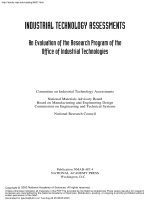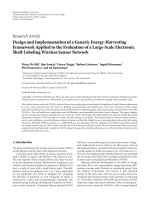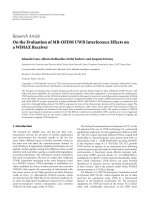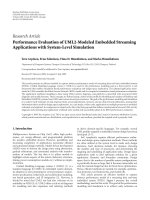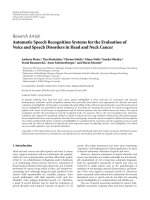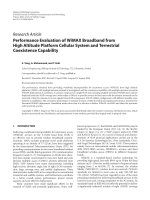Phytotherapy research 2004 karimi evaluation of the gastric antiulcerogenic effects of portulaca oleracea l extracts
Bạn đang xem bản rút gọn của tài liệu. Xem và tải ngay bản đầy đủ của tài liệu tại đây (58.37 KB, 4 trang )
484
PHYTOTHERAPY RESEARCH
Phytother. Res. 18, 484–487 (2004)
Published online in Wiley InterScience (www.interscience.wiley.com).
DOI: 10.1002/ptr.1463
G. KARIMI ET AL.
Evaluation of the Gastric Antiulcerogenic
Effects of Portulaca oleracea L. Extracts
in Mice
Gholamreza Karimi1*, Hossein Hosseinzadeh2 and Negin Ettehad1
1
Department of Pharmacodynamy and Toxicology, Faculty of Pharmacy, Mashad University of Medical Sciences.
Mashad, Iran
2
Pharmaceutical Research Center, Mashad University of Medical Sciences. Mashad, Iran
Portulaca oleracea is commonly used in Iranian folk medicine. The aqueous and ethanolic extracts were
studied in mice for their ability to inhibit gastric lesions induced by HCl or absolute ethanol. In addition, their
effects on gastric acid secretion were measured. Both extracts showed a dose-dependent reduction in severity
of ulcers. The highest dose of extracts exerted similar activity to sucralfate. The oral and intraperitoneal
administration of extracts reduced the gastric acidity in pylorus-ligated mice. These results suggest that Portulaca
oleracea has gastroprotective action and validates its use in folk medicine for gastrointestinal diseases. Copyright © 2004 John Wiley & Sons, Ltd.
Keywords: Portulaca oleracea; antiulcer; folk medicine.
INTRODUCTION
MATERIALS AND METHODS
Portulaca oleracea L. (Portulacaceae) is a summer
annual which is grown as a vegetable in many parts
of the world. This half-hardy low growing plant has
slightly succulent leaves and stems that are used raw or
cooked. There are green and yellow leaved forms; the
green type has thinner leaves, is more vigorous and
possibly better flavoured, but the yellow or golden form
is attractive in salads (Brickell, 1992).
Recent pharmacological studies, have showed
muscle relaxant activity (Okwuasaba et al., 1987a,b,c;
Parry et al., 1993), reduction in locomotor activity,
increase in the onset time of pentylenetetrazole-induced
convulsion (Radhakrishnan et al., 2001), analgesic and
anti-inflammatory effects (Chan et al., 2000).
It is used in Iranian folk medicine as a diuretic,
vermifuge, antiscorbutic, antitussive, analgesic and
in gastroesophageal reflux (Zargari, 1981; Mirheidar,
1995). In traditional medicine, this plant is utilized as
antivomiting, antibleeding, antihepatitis and in treatment of gastric mucosal diseases (Zannavi, 1999;
Rojhan, 1995). In some middle east countries, it is
considered beneficial for small tumors and inflammation, urinary disorders, liver obstruction and ulcers of
mouth and stomach (Miller and Morris, 1988;
Usmanghani et al., 1997). Therefore, it was planned
to study the preventive antiulcer activity of extracts
prepared from Portulaca oleracea.
Plant material. The leaves of the plant were obtained
from a cultivation located in Khaje-rabi (a village near
Mashad, Khorasan province) and identified by Botany
Institute, University of Ferdowsi. A voucher specimen
was deposited at the herbarium of Mashad Pharmacy
School, under the number 240-1615-12.
* Correspondence to: Dr G. Karimi, Department of Pharmacodynamy
and Toxicology, Faculty of Pharmacy, Mashad University of Medical
Sciences, P.O. Box: 91775-1365. Mashad, Iran.
E-mail:
Contract/grant sponsor: Mashad University of Medical Sciences.
Copyright © 2004 John Wiley & Sons, Ltd.
Copyright © 2004 John Wiley & Sons, Ltd.
Preparation of extract. The plant material was dried
in shade, ground and extracted with 80% ethanol or
distilled water by maceration at room temperature
for 24 h. The extracts were filtered and dried at 40 °C
under vacuum. The yield (w/w) of the ethanolic or aqueous extracts were 10.9% and 6.9%, respectively.
Phytochemical screening. Phytochemical screening
of the extracts was performed using the following
reagents and chemicals (Evans, 1996): alkaloids with
Dragendroff’s reagent, flavonoids with the use of
Mg and HCl, tannins with 1% gelatin and 10% NaCl
solutions and saponins with ability to produce suds
and hemolysis reaction.
Animals. Male albino Balb/c mice, weighing 25–35 g
housed in ventilated rooms at temperature of 24 ± 2 °C
with a 12 h light/dark cycle and 60 ± 5% humidity. They
were provided with food and water ad libitum. Twenty
four hours before each experiment, the animals were
deprived of food but not of water.
Acute toxicity. Different doses of the extracts were
injected intraperitoneally into groups of six mice. The
number of deaths was counted at 24 h after treatment.
LD50 values were determined by the litchfield and
wilcoxon method (PHARM/PCS, Version 4).
January(2004)
2003
Phytother.Received
Res. 18, 16
484–487
Accepted 19 June 2003
485
ANTIULCEROGENIC EFFECTS OF P. OLERACEA
Statistical analysis. The results are expressed as mean ±
SEM. Data were analyzed by one-way analysis of variance. Sequential differences among means were calculated at the level of p < 0.05, using Tukey contrast
analysis or Dunn’s test as needed.
HCl or ethanol induced gastric mucosal membrane
lesions. The method is based on the modification of
Mizui and Doteuchi (1983). The mice were divided into
groups of six animals. After 24 h fasting, the mice were
administered extracts or drugs orally. Thirty minutes
later, each mouse received 0.2 ml of 1N HCl or absolute ethanol orally. Each animal was anaesthatized with
ether 1 h after the administration of necrotizing agents,
and the stomach was excised and inflated by injection
of 2 ml saline. The ulcerated stomachs were fixed in
5% formalin for 30 min. After opening along the greater
curvature, HCl-induced gastric damage was observed
as elongated black-red lines (1–10 mm long by 0.5–
1.5 mm wide) parallel to the long axis of the stomach
in mice. The lesion index was expressed as the sum of
the length (mm) of all lesions, especially in the fundic
region (Sun et al., 1991).
The severity of gastric mucosal damage induced by
ethanol were noted and scored on an arbitrary 0–4 point
scale as following: (1) low inflammation; (2) moderate
inflammation and hyperemia; (3) moderate submucosal
hemorrhagic lesions with small erosions; (4) severe
submucosal hemorrhagic lesions with small erosions.
RESULTS
The aqueous and ethanolic extracts showed positive
reactions for flavonoids and tannins. The LD50 values
of the aqueous and ethanolic extracts were 1.22g/kg
(0.8–1.77) and 2.99 g/kg (1.99–2.53), respectively.
On induction of gastric ulceration by using HCl,
pretreatment with the aqueous and ethanolic extracts
showed a dose-dependent reduction in the severity of
ulcers (Table 1). The dose of 0.8 g/kg of the aqueous
extract and 1.4 g/kg of the ethanolic extract had similar
activity to sucralfate (0.1 g/kg). In lesions induced by
ethanol, the dose of 0.56 g/kg and 0.8 g/kg of the aqueous extract and 0.8 g/kg and 1.4 g/kg of the ethanolic
extract showed significant inhibition of lesions (Table
2). The oral and intraperitoneal doses of both extracts
inhibited the total gastric acidity in the pylorus-ligated
mice in a dose-dependent manner (Tables 3 and 4).
The highest dose of extracts had antisecretory activity
which was comparable to cimetidine.
Measurement of gastric secretion. Determination of
pH and HCl concentration in gastric secretion were
studied according to the method described by Basile
et al. (1990). One hour after administration (oral or
i.p.) of the extracts or cimetidine, the groups were subjected to pyloric-ligature under ether anaesthesia. The
animals were sacrified 2 h after pyloric obstruction,
gastric juice was collected, anoted and centrifuged
at 2000 rpm for 10 min. The supernatant was removed
and the pH was recorded by a digital pH meter. Total
acid output was determined by titration with 0.05 N
NaOH.
DISCUSSION
Results obtained in this study suggest that P. oleracea
protects mice from aggressive factors and its administration reduced total gastric acidity and increased pH
Table 1. Effects of various oral doses of aqueous or ethanolic extracts of P. oleracea on HCl (1N) induced gastric ulcers in mice
Aqueous
Treatment
Dose(g/kg)
Saline
Extract
Extract
Extract
Extract
Sucralfate
0.30 ml
0.08
0.32
0.56
0.80
0.10
Ethanolic
Ulcer index (mm)
Inhibition (%)
Dose (g/kg)
±
±
±
±
±
±
–
36.5*
57.8*
68.5*
74.9*
73.9*
0.3 ml
0.2
0.8
1.4
–
0.1
39.16
24.83
16.50
12.33
9.83
10.16
3.20
1.60
1.64
1.21
1.94
1.16
Ulcer index (mm)
±
±
±
±
–
10.83 ±
38.83
26.83
17.16
10.50
4.30
1.72
1.47
1.51
1.26
Inhibition (%)
–
30.9***
55.6***
72.9***
–
72.1***
* P < 0.001 compared to control (saline), values represent the means ± SEM, n = 6.
Table 2. Effects of various oral doses of aqueous or ethanolic extracts of P. oleracea on absolute
ethanol induced gastric lesions in mice
Aqueous
Treatment
Dose (g/kg)
Saline
Extract
Extract
Extract
Extract
Sucralfate
0.30 ml
0.08
0.32
0.56
0.80
0.10
Ethanolic
Lesion score
3.83
2.66
2.10
1.33
0.50
0.50
±
±
±
±
±
±
0.16
0.33
0.30
0.21**
0.22***
0.22***
Dose (g/kg)
0.3 ml
0.2
0.8
1.4
–
0.1
Lesion score
3.83
3.00
2.00
1.00
±
±
±
±
0.16
0.25
0.25*
0.25***
–
0.50 ± 0.22***
*** p < 0.001; ** p < 0.01; * p < 0.05 compared to control (saline), values represent the means
± SEM, n = 6.
Copyright © 2004 John Wiley & Sons, Ltd.
Phytother. Res. 18, 484–487 (2004)
486
G. KARIMI ET AL.
Table 3. Effects of various oral doses of aqueous or ethanolic extracts of P. oleracea on pH and total gastric acid in pylorus ligated mice
Aqueous
Treatment
Dose (g/kg)
Saline
Extract
Extract
Extract
Extract
Cimetidine
0.30 ml
0.08
0.32
0.56
0.80
0.032
pH
3.37
3.94
4.18
4.39
4.47
4.54
±
±
±
±
±
±
Ethanolic
+
0.05
0.04*
0.02*
0.03*
0.05*
0.04*
µEq (H )
Dose (g/kg)
±
±
±
±
±
±
0.3 ml
0.2
0.8
1.4
–
0.032
20.83
9.16
7.50
5.41
5.41
5.00
2.1
1.3*
1.3*
1.1*
1.3*
0.9*
pH
± 0.05
± 0.02*
± 0.02*
± 0.04*
–
4.56 ± 0.09*
3.46
3.84
4.01
4.37
µEq (H+)
±
±
±
±
–
5.00 ±
20.83
10.83
8.33
5.83
2.1
1.3*
1.4*
1.2*
0.9*
* p < 0.001 compared to control (saline), values represent the means ± SEM, n = 6.
Table 4. Effects of various intraperitoneal doses of aqueous or ethanolic extracts of P. oleracea on pH and total gastric acid in pylorus
ligated mice
Aqueous
Treatment
Dose (g/kg)
Saline
Extract
Extract
Extract
Extract
Cimetidine
0.30 ml
0.08
0.32
0.56
0.80
0.032
pH
3.37
4.37
4.75
5.31
5.63
6.23
±
±
±
±
±
±
0.04
0.05*
0.03*
0.03*
0.04*
0.04*
Ethanolic
+
µEq (H )
Dose (g/kg)
±
±
±
±
±
±
0.3 ml
0.2
0.8
1.4
–
0.032
20.0
7.50
5.00
2.5
2.45
2.35
0.1
0.1*
0.2*
0.2*
0.2*
0.1*
pH
± 0.04
± 0.06*
± 0.06*
± 0.07*
–
6.25 ± 0.07*
3.75
4.03
4.54
5.56
µEq (H+)
±
±
±
±
–
2.40 ±
20.0
7.50
5.00
2.50
0.1
0.1*
0.1*
0.2*
0.1*
* p < 0.001 compared to control (saline), values represent the means ± SEM, n = 6.
of gastric juice. It is reported that oxygen radicals generated from neutrophils play important roles in gastric
mucosal lesion induced by HCl/ethanol (Matsumoto
et al., 1993). Ethanol produces lesions in the gastric
mucosa by reducing the secretion of bicarbonate and
mucus (Marhuenda et al., 1993). The products of the 5lipooxygenase pathway may also play a key role in the
development of ulcers induced by irritant agents such
as ethanol (Lange et al., 1985).
Phytochemical studies revealed the presence of
flavonoids and tannins. Also alpha-tocopherol, ascorbic acid, beta-carotene and glutathione determind in
the leaves of the plant (Simpoulos et al., 1992).
Flavonoids have a wide range of biological effects, including antiulcer activity (Di Carlo et al., 1999). Several
mechanisms have been proposed to explain the
gastroprotective effect of flavonoids; these include
increase of mucosal prostaglandin content, decrease of
histamine secretion and free radical scavenging activity
(Borrelli and Izzo, 2000). Tannins are known to ‘tan’
the outermost layer of the mucous and to render it
less permeable and more resistant to chemical and
mechanical injury or irritation (Asuzu and Onu, 1990).
Since flavonoids, tannins and antioxidants have been
shown to present in extracts, it may be suggested that
these constituents implicated in the antiulcer activity of
the extracts. Also this plant comprises some mucilages
(Mirheidar, 1995). It is possible to suppose an involvement of P. oleracea mucilages in the observed effects.
Mucilaginous drugs have the property of covering and
protecting the mucosa of the stomach (Trachtenberg
and Mayer, 1981).
Gastric acid and pH are important factors for ulceration of pylorus-ligation (Sun et al., 1991). P. oleracea
extracts decreased total gastric acidity not only upon
oral administration but also by intraperitoneal route.
These results indicated that the extracts exert their
activity through local and systemic action in stomach.
This protection may be an acid neutralizing action
or antisecretory activity via antagonizing muscarinic or
H2 receptors.
In conclusion, P. oleracea showed a beneficial preventive effect on gastric ulcers induced by HCl or
ethanol. Further studies are needed to elucidate the
mechanisms involved in this activity.
Acknowledgements
The authors are thankful to the Vice Chancellor of Research, Mashad
University of Medical Sciences for financial support and Dr Moallem
for editorial and grammatical assistance.
REFERENCES
Asuzu IU, Onu OU. 1990. Antiulcer activity of the ethanolic
extract of Combretum dolichopetalum root. Int J Crude Drug
Res 28: 27–32.
Basile AC, Sertie JAA, Panizza S, Oshiro TT. 1990. Pharmacological assay of Casearia sylvestris. Prevenentive
antiulcer activity and toxicity of the leaf crude extract.
J Ethnopharmacol 30: 185–197.
Copyright © 2004 John Wiley & Sons, Ltd.
Borrelli F, Izzo AA. 2000. The plant kingdom as a source of
antiulcer remedies. Phytother Res 14: 581–591.
Brickell C. 1992. Encyclopedia of Gardening. Dorling Kindersley:
London; 337.
Chan K, Islam MW, Kamil M, et al. 2000. The analgesic and
anti-inflammatory effects of Portulaca oleracea L.subsp.
sativa (haw) Celak. J Ethnopharmacol 73: 445–451.
Phytother. Res. 18, 484–487 (2004)
ANTIULCEROGENIC EFFECTS OF P. OLERACEA
Di Carlo G, Mascolo N, Izzo AA, Capasso F. 1999. Flavonoids:
old and new aspects of a class of natural therapeutic drugs.
Life Science 64: 337–353.
Evans WC. 1996. Trease and Evans’ Pharmacognosy. Tindall
Press: London; 161–166.
Lange K, Peskar BA, Peskar BM. 1985. Stimulation of rat mucosal
leukotriene formation by ethanol. Naunyn Schmiedebergs
Archiv Fur Pharmakologie 3305: 27.
Marhuenda E, Martin MJ, Alarcon de la lastera C. 1993.
Antiulcerogenic activity of aescine in different experimental
models. Phytother Res 7: 13–16.
Matsumoto T, Moriguchi R, Yamada H. 1993. Role of polymorphonuclear leucocytes and oxygen derived free radicals in the formation of gastrist lesions induced by HCl/
ethnol, and a possible mechanism of production by antiulcer
polysaccharide. J Pharm Pharmacol 45: 535–539.
Miller AG, Morris M. 1988. Plants of Dhofa, the Southern Region of Oman. TraditionaI, Economical and Medicinal Uses.
The Office of the Advisor for Conservation of Environment,
Diwan of Court, Sultanate of Oman.
Mirheidar H. 1995. Encyclopedia of Plants, Vol 1. Islamic Culture Press: Tehran; 72–76.
Mizui T, Doteuchi M. 1983. Effect of polyamines on acidified
ethanol induced gastric lesions in rats. Jap J Pharmacol 33:
939–945.
Okwuasaba F, Ejika C, Parry O. 1987a. Effects of extracts of
Portulaca oleracea on skeletal muscle in vitro. J Ethnopharmacol 27: 55–63.
Okwuasaba F, Ejika C, Parry O. 1987b. Comparison of the
Copyright © 2004 John Wiley & Sons, Ltd.
487
skeletal muscle relaxant properties of Portulaca oleracea
extracts with dantrolene sodium and methylverapamil.
J Ethnopharmacol 20: 85–106.
Okwuasaba F, Parry O, Ejika C. 1987c. Investigation into the
mechanism of action of extracts of Portulaca oleracea.
J Ethnopharmacol 27: 91–97.
Parry O, Marks JA, Okwuasaba F. 1993. The skeletal muscle
relaxant action of Portulaca oleracea: role of potassium ions.
J Ethnopharmacol 40: 187–194.
Radhakrishnan R, Zakaria MNM, Islam MW, et al. 2001. Neuropharmacological actions of Portulaca olerace L. v sativa
(Hawk). J Ethnopharmacol 76: 171–176.
Rojhan MS. 1995. Herbal Drugs and Treatment. Alavi Press:
Tehran; 125.
Simopoulos AP, Norman HA, Gillaspy JE, Duke JA. 1992.
Common purslane: a source of omega-3 fatty acids and
antioxidants. J Amerian College Nut 11: 374–382.
Sun XB, Matsumoto T, Yamada H. 1991. Effects of a polysaccharide fraction from the roots of Bupleurum falcatum
L. on experimental gastric ulcer models in rats and mice.
J Pharm Pharmacol 43: 699–704.
Trachtenberg S, Mayer AM. 1981. Composition and properties
of Opuntia ficus indica mucilage. Phytochem 20: 2665–2668.
Usmanghani K, Saeed A, Alam MT. (eds). 1997. Indusyunic
Medicine University of Karachi: Pakistan.
Zannavi MA. (ed). 1999. Avicenna Canon, Vol 1. Dar al-kotob al
llmyah: Beirut; 404–406.
Zargari A. 1981. Medicinal Plants, Vol 1. University Press: Tehran;
218–220.
Phytother. Res. 18, 484–487 (2004)
